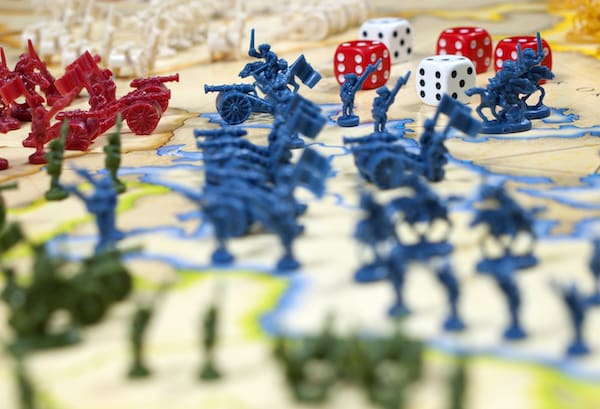How do wargames work in the 2020s? Particularly with recent developments in AI, wargames can have an environment as sophisticated as you can imagine, or as simple as mere words on a screen. According to Sentient Digital, Inc.’s Artificial Intelligence Research Scientist and Marine Corps Veteran Gene Locklear, developments in wargames AI have changed the nature and availability of these useful (and fun!) exercises. From students to soldiers to corporate employees, many people have gotten involved in wargames. Read on for Gene’s insights into the status, benefits, and future of wargames.
What are Wargames?
Wargames are just what they sound like: games that simulate a conflict, such as a war, allowing the players to create and implement strategies and deal with conditions and setbacks in order to achieve objectives. They have existed for a very long time, appearing in forms from tabletop games to text-only platforms. These games may have recently gained more popularity due to technological advances that have increased the ability of the game to simulate the expertise of real warfighters and the situations encountered on the battlefield.
As Locklear put it, “Wargaming is becoming popular now because the technology for it is cheap. You can mass produce it for soldiers. It saves money. You can train ‘people’ (avatars) in complete simulation.”
Types of Wargames and Their Applications
Naturally, when you think of wargames, you may imagine some type of simulation of opposing armies. However, wargames can also extend beyond a military setting. The label “wargames” can also apply to situations such as businesses competing against other businesses to sell products, or political campaigns and their political opponents. It can also have a fantasy element and control armies of elves or dwarves.

Although it may not initially occur to you, chess was actually a very early example of a wargame. Thought to have originated in India in the 6th Century C.E., chess remains popular to this day. The reasons for this are many, but likely include the thrill of taking on an opponent in a battle of wits and the importance of learning the kind of strategic thinking required for success in the game.
Some more recent classic examples of wargames include Risk (from the 1950s) and Axis and Allies (from the 1980s), which are both tabletop games that allow the player to assume the role of a military commander of a fictionalized version of historical armies. These games, which use a tabletop board game format, are just some of the many classic wargames that historically have allowed players to build strategic skills during an enjoyable pastime. Perhaps without realizing it, players began to develop skills that may be useful on real life battlefields, literal or metaphorical.
Since the advent of personal computers, developers have had the opportunity to develop wargames with a variety of levels of complexity using this medium. From playing chess against a virtual opponent to encountering extremely realistic environmental conditions and enemy ploys, computers have literally changed the game. Video games such as the Call of Duty series, originating in 2003, may be considered wargames as they endeavor to simulate combat experiences. However, as we will discuss, artificial intelligence has recently shifted the wargames’ simulation aspect into overdrive.
So, How Do Wargames Work?
Originally, to play a computer-based wargame, you were limited because of the graphics. It made a lot more sense to build a text-based version. With any idea, you can build a simulation. When you build, it’s not just one person; it usually takes a whole team of individuals to cover and build all the aspects of the wargame program.
AI Changes Wargaming
Currently, wargaming uses a cognitive AI simulation to emulate the way humans think. You can build really good simulations with an AI expert or a military professional. People can get confused when they look at a game and think that it’s just the AI thinking. But how do wargames work with AI? The AI is designed to make you think that it’s thinking, simulating human intelligence. Without AI, you can’t do that with a military simulation. You need to have advanced, expert military human knowledge on both sides, and have the wargame to be advanced enough that it’s an accurate simulation of what a human would decide to do with all their years of experience.
Locklear noted that, “To build a wargame program, you adapt a cognitive platform from scratch. The issue with building a platform is that you need to understand the underlying math behind it and learn what you want to do with it and then make those changes and experiment with it. You get people to ‘play’ with the program so it can learn from them. The main thing is the number of resources. If you have lots of funding, you can have people full-time working on it and developing different parts of it. There’s a bit of promoting interest to get someone to fund you. To build these wargame programs, you develop the idea and promote them with a bigger partner who has the resources to build it up.”
However, Locklear explained that the flashiness of some modern wargames is not strictly necessary. “If you ignore the graphics, you can build a really good AI system with a text output to reflect the decisions. You get the logic in there and it’s just a lot of information. For example, Sentient Digital’s Red Emergence is similar, found under our Enabling Technology capability. You have the human emulation of a Russian brigade and the level of the commander; you can build algorithms of how it would take place and test it. You can set the stats and continue to improve it over time,” he said.

Benefits of Wargames
Wargaming is about the decision-making process and seeing how that decision influences the opposition or how that decision would influence any given situation. Explaining the practicalities, Locklear stated that, “In a real-world sense, wargaming can be used to see how complex it can get and what additional factors are at play. You can bring in officials for a wargaming simulation to see how it would play out and if it would be worth it. You can see the results and affect political decisions because wargaming shows the consequences. As you see those consequences, you can prevent them taking place in the first place, you see how weather and the environment affects the decisions as well. You see what you might gain, see what you might lose. Is it a feasible course of action? There’s an advantage to seeing how things would play out in the real world, but in the safe environment of a game.”
While there are clear benefits of wargaming for those who are interested in a military or policy career, there are many reasons to play wargames beyond these objectives. Quick thinking, taking calculated risks, responding to unexpected developments, and more, are skills that will serve a person well in many careers and areas of their life.
How Do Wargames Work at Universities? Georgetown University’s Programs
Noting the value of wargames for military training as well as general strategic thinking, universities have begun to offer classes and activities in wargaming. For example, Georgetown University offers a graduate Security Studies program that includes a course called “Basics of Wargaming,” taught by faculty including Adjunct Assistant Professor Sebastian Bae. This course presents students with the opportunity to learn about military strategy and philosophy but also has a hands-on aspect, with students, “researching, designing, developing, and play-testing an original educational wargame on a topic related to military strategy.” Rather than only listening to lectures, students are able to truly engage with military strategy in a way that will impart the knowledge to them in a memorable way through games.
Additionally, connecting the university community to the community as a whole, Georgetown also has a Wargaming Society, which is essentially a club for people (including non-students) that enjoy wargaming, attending wargaming events, and getting to know others who share these interests. Through programs such as these, universities help to maintain and even increase the interest in wargames, while also developing a future generation of military, policy, and business leaders.
Want to Know More About Sentient Digital’s Work in Artificial Intelligence and Support of Warfighters?
How do wargames work to build your career in business, tech, and beyond? If you love wargaming now, you will likely find that the skills you gained from these experiences will serve you well in your professional career, where strategic thinking makes you an asset. Sentient Digital and its anti-submarine warfare-focused subsidiary RDA, focus on providing technology solutions for military, government, and private sector clients. We like to hire people who enjoy a fast-paced environment where your contribution matters and where innovative thinking is valued. For those who do follow their passion for wargaming into a military career, consider that we also proudly hire Veterans, who bring valuable skills gained in service to our team. Check out our current job postings and see what would be a good fit for you!




